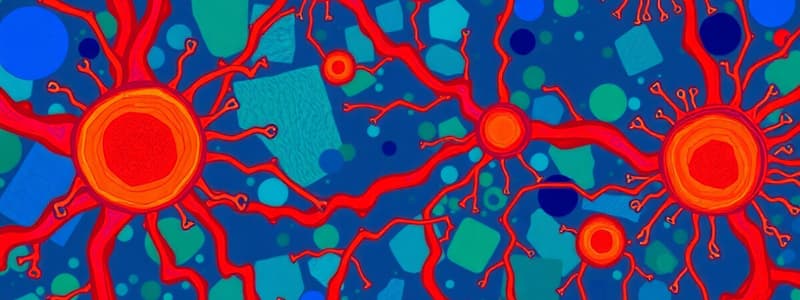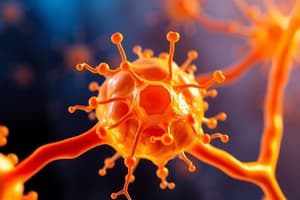Podcast
Questions and Answers
What is one of the primary functions of cell surface receptors?
What is one of the primary functions of cell surface receptors?
- Facilitation of DNA replication
- Production of antibodies
- Degradation of cellular waste
- Induction of intracellular signaling (correct)
What initial event often characterizes signal transduction pathways initiated by cell surface receptors?
What initial event often characterizes signal transduction pathways initiated by cell surface receptors?
- Clustering of receptor proteins (correct)
- Dephosphorylation of proteins
- Release of lipid soluble ligands
- Formation of nuclear receptors
Which of the following describes the role of protein kinases in signal transduction?
Which of the following describes the role of protein kinases in signal transduction?
- They remove phosphate groups from amino acids
- They add phosphate groups onto amino acid side chains (correct)
- They act as inhibitors of receptor activity
- They deplete energy from cells
How do nuclear receptors differ from cell surface receptors?
How do nuclear receptors differ from cell surface receptors?
What typically occurs during the cytosolic phase of signal transduction?
What typically occurs during the cytosolic phase of signal transduction?
Which of the following molecules can be directly recognized by cell surface receptors to initiate signaling?
Which of the following molecules can be directly recognized by cell surface receptors to initiate signaling?
What is the main function of the hypervariable regions in the TCR?
What is the main function of the hypervariable regions in the TCR?
How many complementarity-determining regions (CDRs) does the TCR α chain have?
How many complementarity-determining regions (CDRs) does the TCR α chain have?
What is the primary role of CD4 and CD8 coreceptors in T cell activation?
What is the primary role of CD4 and CD8 coreceptors in T cell activation?
Which structure do CD4 coreceptors primarily interact with?
Which structure do CD4 coreceptors primarily interact with?
What characterizes the assembly of the immune synapse?
What characterizes the assembly of the immune synapse?
Which statement is true regarding the structure of CD8 molecules?
Which statement is true regarding the structure of CD8 molecules?
What is the main role of non-receptor tyrosine kinases in receptor activation?
What is the main role of non-receptor tyrosine kinases in receptor activation?
Which type of receptors are activated by multivalent extracellular ligands?
Which type of receptors are activated by multivalent extracellular ligands?
What is a primary function of nuclear hormone receptors?
What is a primary function of nuclear hormone receptors?
How do G protein–coupled receptors function?
How do G protein–coupled receptors function?
What type of receptors are involved in cell fate determination during lymphocyte development?
What type of receptors are involved in cell fate determination during lymphocyte development?
Which receptors migrate into the nucleus to function as transcription factors?
Which receptors migrate into the nucleus to function as transcription factors?
What is the primary mechanism by which Notch receptors transmit signals?
What is the primary mechanism by which Notch receptors transmit signals?
Which of the following ligands would most likely activate a G protein–coupled receptor?
Which of the following ligands would most likely activate a G protein–coupled receptor?
What is the primary function of non-receptor tyrosine kinases in cellular receptor activation?
What is the primary function of non-receptor tyrosine kinases in cellular receptor activation?
Which type of receptors are activated by binding of multivalent extracellular ligands?
Which type of receptors are activated by binding of multivalent extracellular ligands?
What motifs do immune receptors that activate immune cells commonly possess?
What motifs do immune receptors that activate immune cells commonly possess?
What kind of receptor is the FcγRIIB?
What kind of receptor is the FcγRIIB?
Which components make up the antigen receptor of CD4+ and CD8+ T cells?
Which components make up the antigen receptor of CD4+ and CD8+ T cells?
What is the role of inhibitory receptors like PD-1 in T cells?
What is the role of inhibitory receptors like PD-1 in T cells?
What best describes the functional state of nuclear receptors upon ligand binding?
What best describes the functional state of nuclear receptors upon ligand binding?
How are TCR α and β chains connected in the T cell receptor?
How are TCR α and β chains connected in the T cell receptor?
Which of the following receptors uses ITIM motifs for inhibitory signaling?
Which of the following receptors uses ITIM motifs for inhibitory signaling?
What is the primary function of the antigen-binding portion of the T cell receptor?
What is the primary function of the antigen-binding portion of the T cell receptor?
Flashcards are hidden until you start studying
Study Notes
Cell Surface Receptors
- Cell surface receptors can be triggered by external ligands.
- Receptors serve various functions like inducing intracellular signaling, cell adhesion, and internalization of extracellular molecules.
- Signaling initiated by receptors typically involves an initial cytosolic phase where the cytoplasmic portion of the receptor is modified.
- This leads to activation and nuclear translocation of transcription factors, resulting in changes in gene expression.
Signal Transduction
- Signal transduction pathways are also known as intracellular signaling pathways.
- Receptors initiating these pathways are present on the plasma membrane, where their extracellular domains recognize ligands, structures attached to neighboring cells, or the extracellular matrix.
- Nuclear receptors are found intracellularly and are activated by lipid-soluble ligands that can cross the plasma membrane.
- Ligand binding to a receptor may induce clustering or conformational alteration of the receptor.
Phosphorylation in Signal Transduction
- A common early event in signal transduction is the addition of a phosphate residue to tyrosine, serine, or threonine residues in the cytosolic portion of a receptor or adaptor protein.
- Protein kinases are enzymes that add phosphate groups to amino acid side chains.
- Protein tyrosine kinase phosphorylates specific tyrosine residues.
Categories of Cellular Receptors
- Non-receptor tyrosine kinases: The receptor's cytoplasmic tail lacks intrinsic catalytic activity, but a separate intracellular tyrosine kinase (non-receptor tyrosine kinase) phosphorylates specific motifs on the receptor or its associated proteins.
- Receptor tyrosine kinases (RTKs): These are integral membrane proteins with an intrinsic tyrosine kinase domain in their cytoplasmic tails. The kinase domain is activated when the receptors are cross-linked by multivalent extracellular ligands.
- Nuclear receptors: These receptors are located in the nucleus and function as transcription factors. They bind to lipid-soluble ligands and regulate gene expression.
- G protein-coupled receptors (GPCRs): These receptors activate associated GTP-binding proteins (G proteins). Ligand binding induces a conformational change in the receptor, enabling it to activate a heterotrimeric G protein by exchanging GDP for GTP.
- Receptor proteins of the Notch family: These receptors are involved in development in various species. Ligand binding to these receptors leads to receptor cleavage and nuclear translocation of the cleaved cytoplasmic domain. The domain functions as a component of a transcription complex.
Immune Receptor Family
- Immune receptors that activate immune cells have separate polypeptide chains for recognition and associated polypeptide chains containing cytosolic immunoreceptor tyrosine-based activation motifs (ITAMs).
- The B cell receptor (BCR), T cell receptor (TCR), and the high-affinity receptor for IgE (FcεRI) have ITAM motifs.
- Inhibitory receptors in the immune system typically have immunotyrosine-based inhibitory motifs (ITIMs) in the cytosolic portion of the same chain that handles ligand recognition.
- FcγRIIB is an inhibitory receptor found on B cells and myeloid cells. PD-1, an inhibitory receptor found on T cells, has an immunotyrosine-based "switch" motif in its cytoplasmic tail.
T Cell Receptor for Antigen
- The antigen receptor of MHC-restricted CD4+ helper T cells and CD8+ cytotoxic T lymphocytes (CTLs) is a heterodimer consisting of two transmembrane polypeptide chains, designated TCR α and β.
- The chains are covalently linked by a disulfide bridge between extracellular cysteine residues.
- The antigen-binding portion of the TCR is formed by the Vβ and Vα domains.
- The hypervariable segment loops that form the peptide-MHC binding site are at the top.
Binding of TCR to an MHC molecule
- The V regions of the TCR α and β chains contain hypervariable or complementarity-determining regions (CDRs).
- Three CDRs in the α chain and three in the β chain together form the part of the TCR that specifically recognizes peptide-MHC complexes.
Components of the TCR Complex
- CD4 and CD8 are T cell coreceptors that bind to nonpolymorphic regions of MHC molecules.
- They facilitate signaling by the TCR complex during T cell activation.
- Mature αβ T cells express either CD4 or CD8.
- CD8 interacts with class I MHC molecules, and CD4 interacts with class II MHC molecules.
- CD4 and CD8 are responsible for the class I or class II MHC restriction of these classes of T cells.
Role of CD4 and CD8 Coreceptors in T Cell Activation
- CD4 has four extracellular Ig-like domains, a hydrophobic transmembrane region, and a highly basic cytoplasmic tail.
- The two N-terminal Ig-like domains of CD4 bind to the nonpolymorphic α2 and β2 domains of the class II MHC molecule.
- Most CD8 molecules are disulfide-linked heterodimers composed of two related chains called CD8α and CD8β.
- Both the CD8 α and β chains have a single extracellular Ig domain, a hydrophobic transmembrane region, and a highly basic cytoplasmic tail.
The Immune Synapse
- The immune Synapse forms a stable contact between an antigen-specific T cell and an antigen-presenting cell (APC).
- It serves as the site for assembling the T cell's signaling machinery (TCR complex, coreceptors, costimulatory receptors, and adaptors).
- The immune synapse facilitates prolonged and effective T cell signaling.
- It delivers secretory granule contents and cytokines from a T cell to APCs or target cells in contact with the T cell.
- It may also be a site for turnover of signaling molecules, contributing to the termination of T cell activation.
Signal Transduction
- Phosphorylation of proteins and lipids is crucial in transducing signals from the TCR complex and coreceptors.
- Even before TCR activation, there is some basal tyrosine phosphorylation of ITAM tyrosines.
- ZAP-70 is recruited to these phosphorylated ITAMs.
- Within seconds of TCR ligation, Lck phosphorylates the ITAMs of the CD3 and ζ chains.
Activation of Transcription Factors
- Transcription factors are activated by different cytoplasmic signal transduction pathways.
- Multiple transcription factors account for the activation of many signaling pathways upon antigen recognition. These pathways encode cytokine receptors and effector molecules.
- Nuclear factor of activated T cells (NFAT), AP-1, and NF-κB are three important transcription factors activated in T cells by antigen recognition. They play a significant role in T cell responses.
Studying That Suits You
Use AI to generate personalized quizzes and flashcards to suit your learning preferences.



